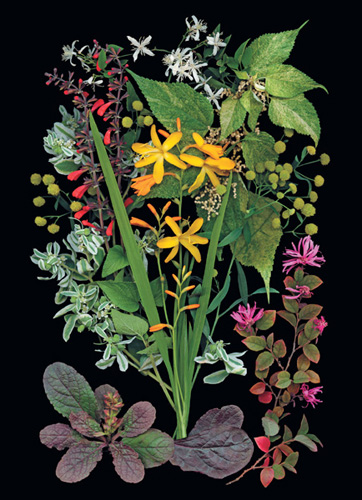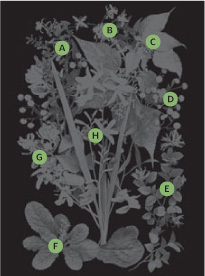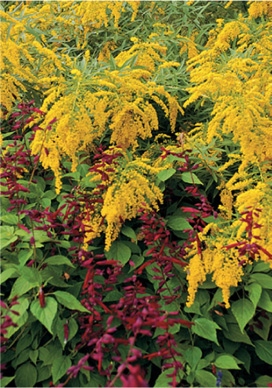
Plants for sun in early autumn at “The Wild Garden” of Wave Hill: A Salvia coccinea ‘Forest Fire’; B Clematis terniflora; C Boehmeria nipononivea ‘Kogane Mushi’; D Boltonia asteroides ‘Nally’s Lime Dots’; E Loropetalum chinensis var. rubrum; F Salvia lyrata ‘Purple Knockout’; G Euphorbia marginata; H Crocosmia ‘George Davidson’.


Every fall, Wave Hill, the public garden in the Bronx, holds their Gardener’s Picnic. It is a very popular event for people interested in horticulture (and plant sales). The big draw is Wave Hill’s incredible gardens, which look great throughout the year (even in winter), but most of all in autumn. Of course, the backdrop of New Jersey’s Palisades—cliffs across the Hudson River—and sunsets beyond the George Washington Bridge don’t hurt.
Marco Polo Stufano, the former director of horticulture at Wave Hill, is one of the few people in the United States who gets to introduce unusual plants to gardeners. When I’ve met up with him at lectures touting “new” plants, he often scoffs, “We grew that at Wave Hill twenty years ago,” or “We threw that on the compost at Wave Hill twenty years ago.” I admire his ability to toss a less-than-stellar plant and move on to brighter things. I’ve coddled sickly plants for decades until they finally gave up the ghost.
A trip to Wave Hill’s gardens, now directed by Scott Canning, is like delving into the pages of a living catalog of must-have treasures. On a recent trip, I met a purple-leafed form of the ground cover Salvia lyrata, a variegated nettle (Boehmeria nipononivea ‘Kogane Mushi’), a short yellow-flowered Crocosmia, and the hardy autumn shrub Loropetalum chinensis ‘Rubrum’ with magenta ribbon flowers growing in a pot in the sunny herb garden.
In the fall, the Wild Garden blooms with discoveries. And the planted containers around the twenty-eight-acre property, filled with tropicals, are equally enlightening. Fortunately, labels accompany most specimens. There are selections that were found and introduced at Wave Hill, like Boltonia asteroides ‘Nally’s Lime Dots’, a rayless daisy family member that sports chartreuse pompoms atop five-foot-tall stems in the fall.
Wave Hill is famous for its containers, many of which are planted as late as July 4 to look perfect for the September picnic. Autumn is peak time for the tropical plants— just before frost when they are to be brought indoors, used for cuttings, or struck down by cold. Great containers can also be found in the Scott Arboretum at Swarthmore College in Pennsylvania under the direction of Andrew Bunting; in Steve Silk’s Connecticut backyard—photographed to illustrate his articles and books; and planted by Dan Benarcik in the entry garden of Chanticleer in Wayne, PA—one of the most innovative gardens in the East today.
In the shortening days of September, a perennial goldenrod combines beautifully with its partner, a refined hybrid of the annual Salvia splendens.
